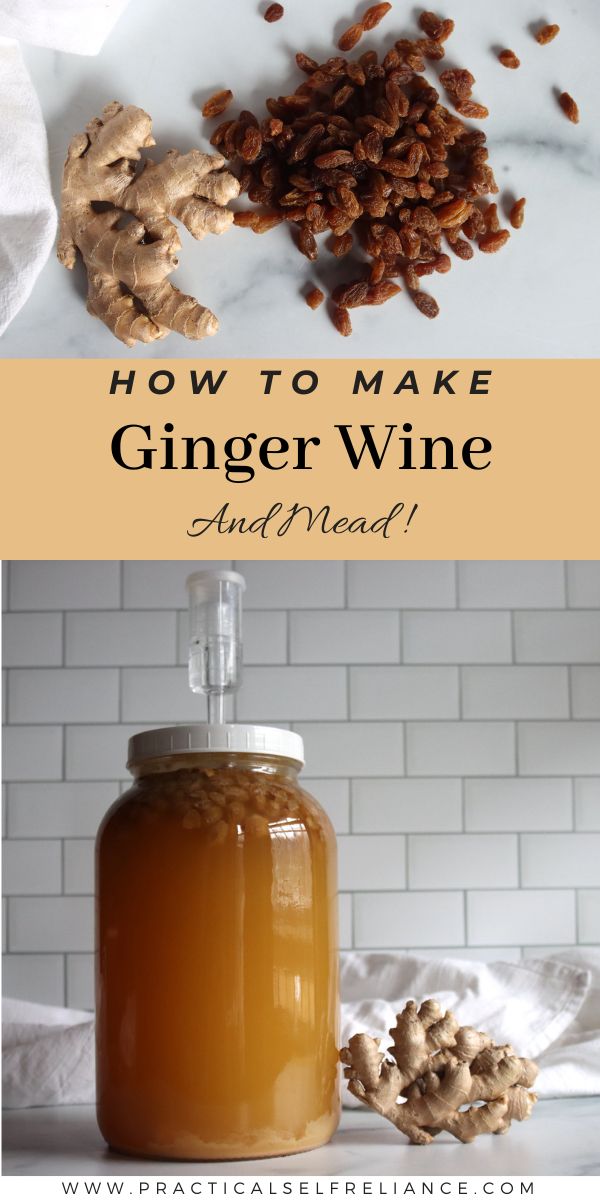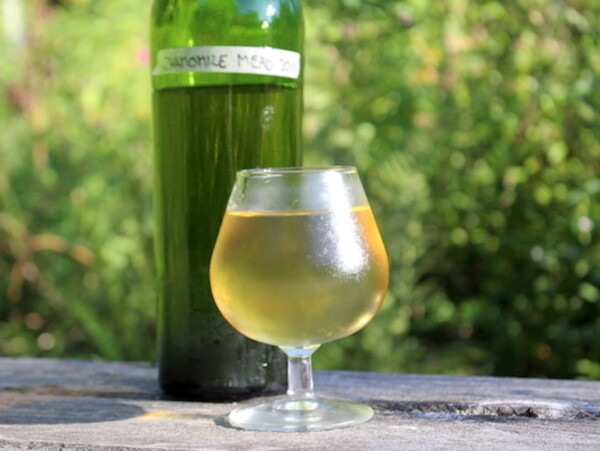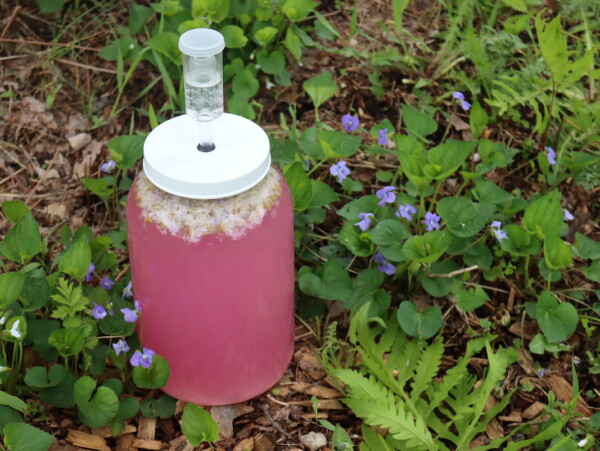Affiliate disclosure: This post may contain affiliate links. Please see our Privacy Policy.
Ginger wine is a lovely warming drink, perfect for sipping on cold, dark evenings. The spicy notes of ginger root lend themselves particularly well to both wine and mead, crafting a flavor that can be enjoyed in the fall months throughout the long, cold winter.
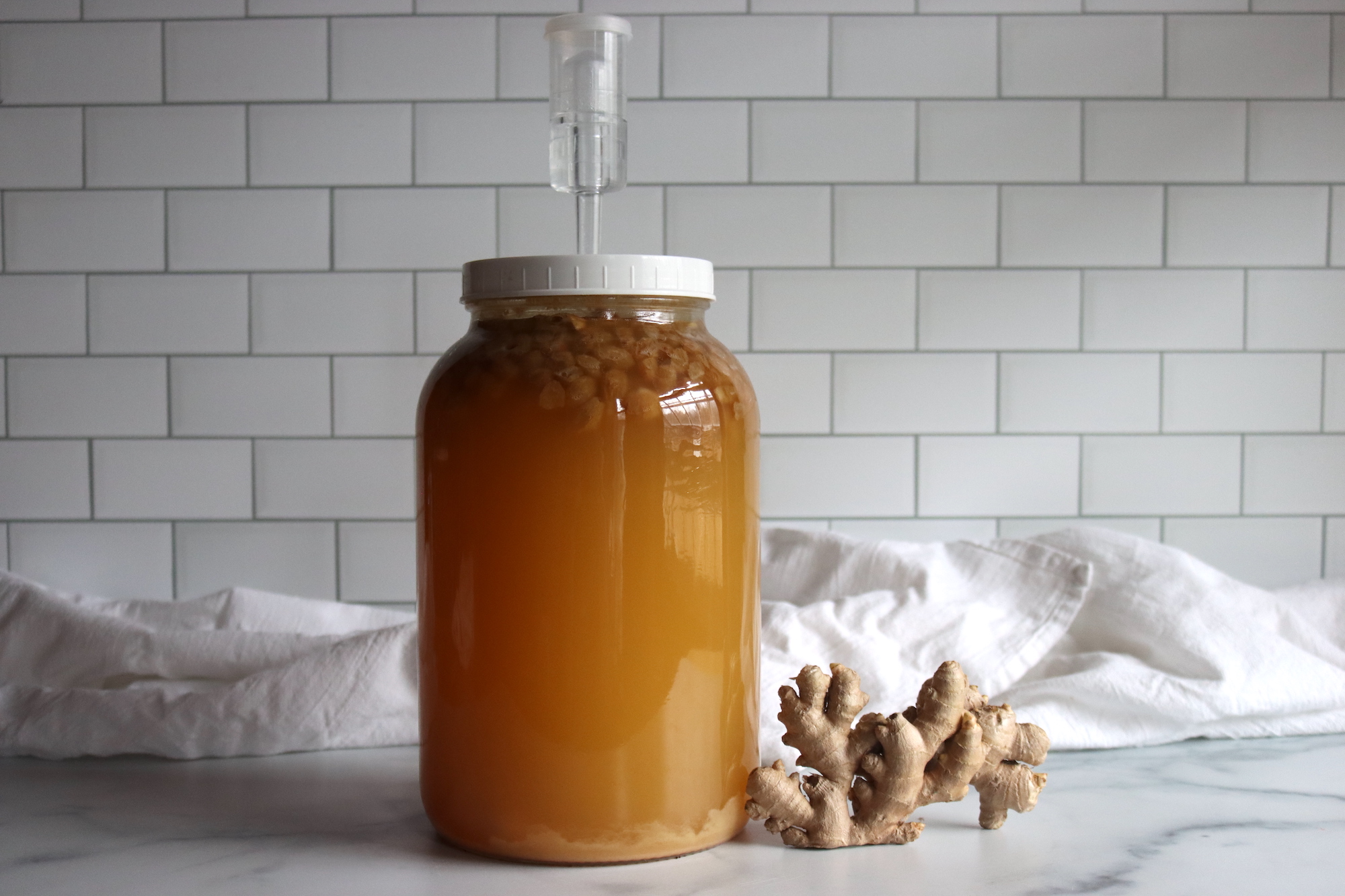
Ginger wine is a delicious country wine with a warm, slightly spicy flavor. It’s popular in the UK, and this particular recipe is adapted from a British winemaking book.
You can make it as a simple homemade mead as well, which will have more body and improve with age. To make a mead, simply replace the sugar with honey and allow a bit more fermentation time. (Honey takes a bit longer for the yeast to convert to alcohol since it’s a slightly more complex sugar.)
Either way, the results are pretty spectacular, and you’ll have plenty of festive ginger flavor in your glass!
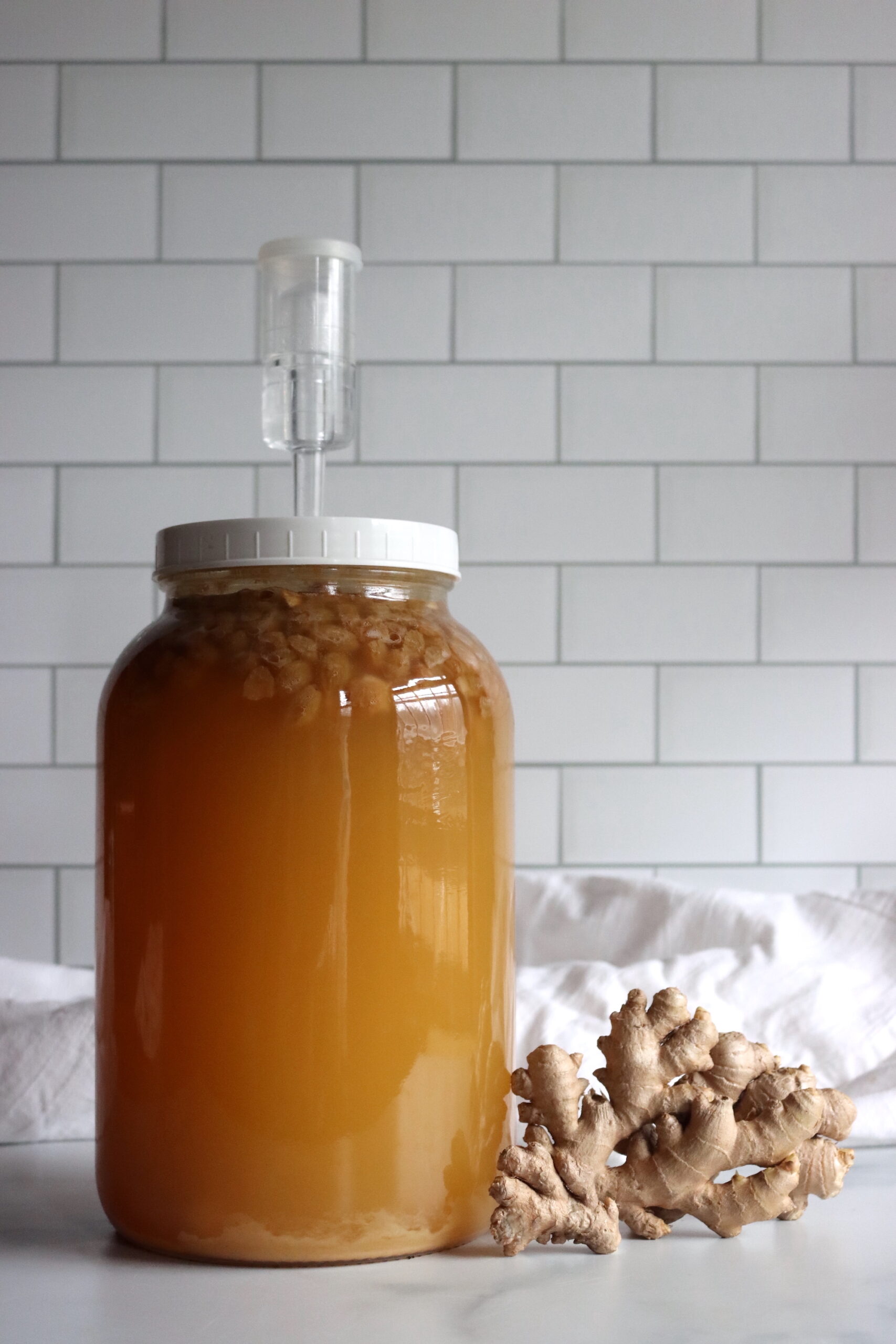
lthough this recipe is pretty straightforward, I’ve written it under the impression that the reader is informed on general winemaking terms and practices. Newer to the realm of winemaking? These introductory guides will help you along your way:
- How to Make Herbal Wine (& Mead) will take you through all the steps in the winemaking process from start to finish.
- How to Make Mead (Honey Wine) is mostly the same, but there are a few important particularities when working with honey.
- Equipment for Winemaking is where you can read about all the durable equipment you’ll need to make your first batch (besides your ingredients).
- Ingredients for Winemaking will cover all the other things you’ll need (other than yeast).
- Yeast for Winemaking may seem intimidating and complicated, given the dozens of common strains (and hundreds of lesser known ones) out there. Read this to learn all about picking the right one for your wine.
Ingredients for Ginger Wine
Before making ginger wine, you’ll need to first gather your ingredients.
Those newer to winemaking may wish to read this handy guide on winemaking ingredients so you have a better sense of what each of these elements does here.
To yield a one-gallon batch of ginger wine, you will need:
- 2 oz ginger root
- 2 lbs granulated sugar
- 7-½ pints white grape juice (unsweetened)
- 1 cup chopped golden raisins
- 1 tsp Yeast Nutrient
- ½ tsp Acid Blend
- ¼ tsp Wine Tannin
- Wine yeast
For a single-gallon batch of ginger wine or mead, you will want to start with 2 oz of ginger root. Besides this, you will also need 2 lbs of granulated sugar for wine or 2 lbs of honey for mead. With mead, you can skip the white grape juice, since that’s added for body and honey gives mead a naturally lush body in the bottle. If you do omit the grape juice, increase the total amount of honey to 3 pounds. (When making a sugar wine, however, the white grape juice is strongly reccomended.)
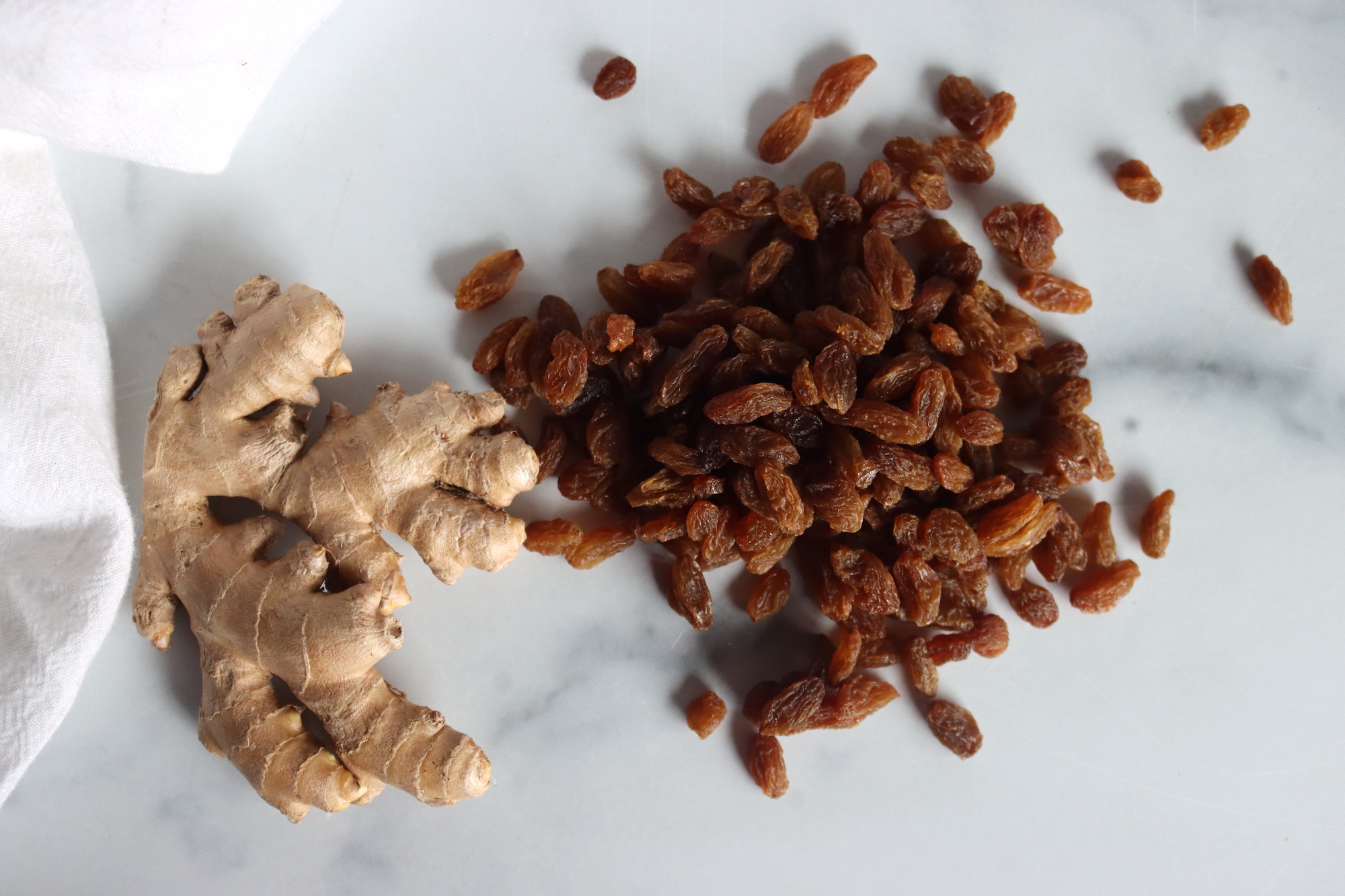
Some unsweetened white grape juice will help add body to your wine. Adding some golden raisins to the mix will also improve body, color and add balance to the wine.
In addition to these ingredients, you’ll need some acid blend and wine tannin to give the wine a good mouthfeel and a small packet of yeast nutrient to keep your wine yeast happy.
For wine yeast, champagne yeast is preferred. Some nice yeast options include strong fermenters like Red Star Premier Blanc, Red Star Premier Cuvee or Lalvin EC-1118. These champagne yeasts have a high alcohol tolerance (15% and occasionally higher in ideal conditions) and can end in a wine that’s quite dry (though this can be counteracted by back sweetening). All have an ideal temperature range between 59°F to 86°F.
Lalvin K1-V1116 is also sometimes used for ginger mead or wine. It has an alcohol tolerance up to 18% and a slightly wider temperature range of 50°F to 95°F.
Beyond all this, some durable winemaking equipment will also be required. This includes:
- One Gallon Glass Carboy (often sold as a kit with a rubber stopper and water lock together)
- Rubber Stopper and Water Lock (if not included above)
- Brewing Siphon
- Wine Bottles or Flip-top Grolsch bottles
- Bottle Corker and clean, new corks for bottling the wine
- Brewing Sanitizer
Making Ginger Wine
Once ready to begin making your batch of ginger wine, slice or shred the ginger root and add it to your primary fermentation vessel along with the chopped raisins.
Next, mix the white grape juice with the sugar, stirring to dissolve. Add to the primary fermentation vessel.
Add the remaining winemaking ingredients (except the wine yeast) and stir to dissolve. The wine yeast should be added last. Rehydrate your yeast in a small amount of room temperature water for about 10 minutes before adding to your carboy.
Seal with a water lock and ferment in primary for 1 to 2 weeks.
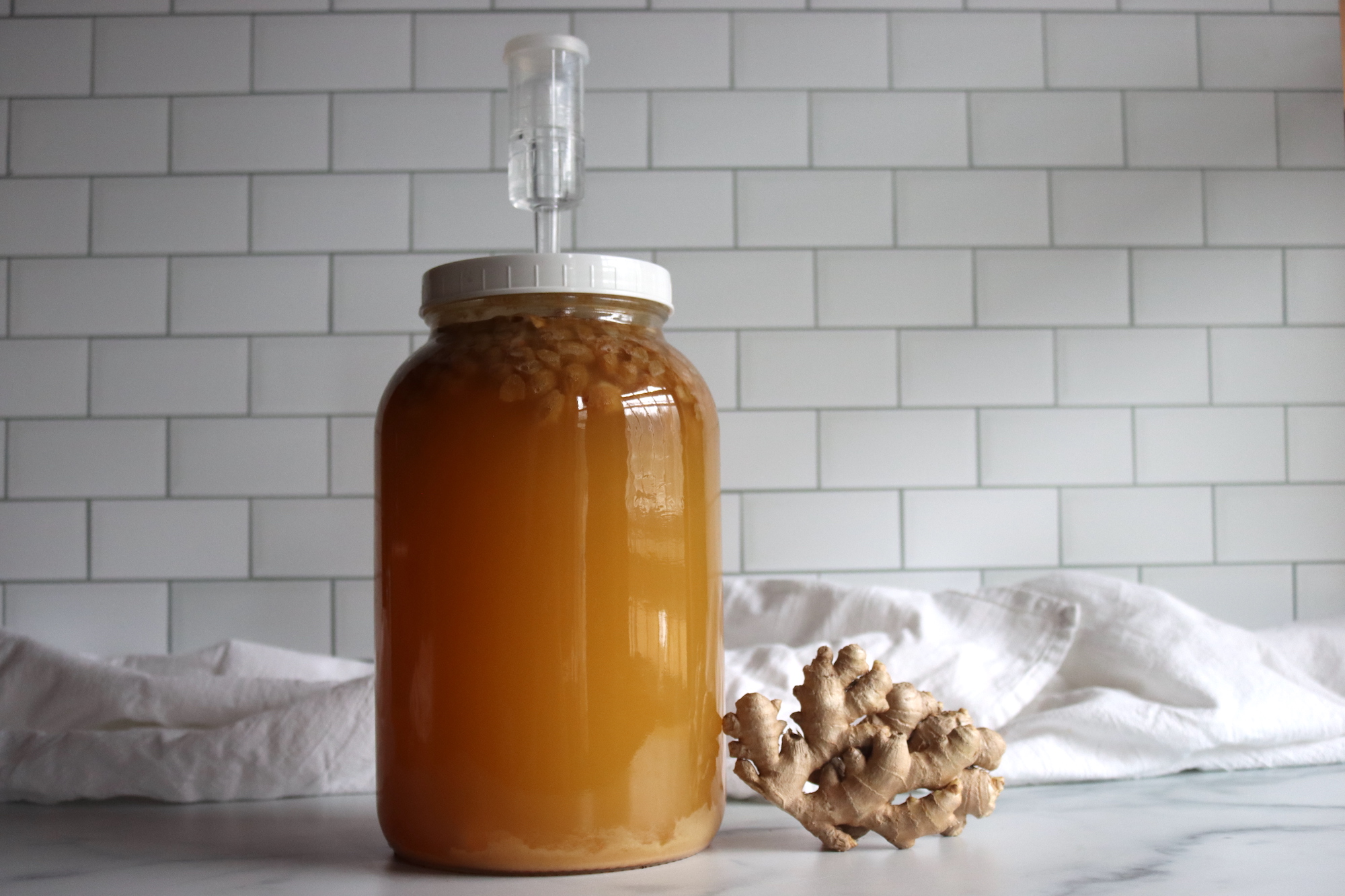
Here is where you’ll see the most active fermentation occurring. In a day or two lots of nice bubbling should be present. Once this ferment begins to slow, you can rack to a clean container for secondary, straining out the ginger root and raisins.
Top with water as needed to bring the wine level up to the neck of the carboy and refit the water lock. Rack again after 30 days, topping up and sealing with the water lock once again.
Ferment another 2 months for wine, longer for mead (the time spent in secondary for mead is 2 to 6 months as honey is a bit more complicated for the yeast to digest than plain old sugar).
Sample your wine at the end of secondary. The wine will be quite dry at this point, so you will likely want to sweeten it.
Before backsweetening, stabilize your wine by adding 1 Campden tablet and ½ teaspoon potassium sorbate. Sweeten as desired by making a simple syrup of equal parts sugar and water and putting it back into ferment for about 10 days before bottling.
This wine can be drunk in a few weeks but will improve more with age. Wait 6 months before drinking for the best tasting experience!
Ways to Preserve Ginger
In need of more ways to preserve ginger root?
- Simple Ginger Marmalade (Ginger Jam)
- Canning Pickled Ginger
- How To Make Candied Ginger
- How to Dehydrate Ginger and Make Ginger Powder
- Ginger Vinegar
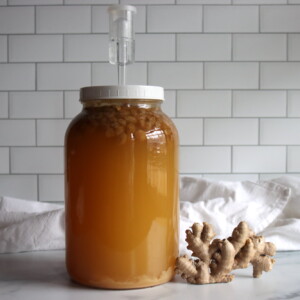
Ginger Wine (& Mead)
Equipment
- Air Lock & Stopper
Ingredients
- 2 oz ginger root
- 2 pounds Sugar, about 4 cups
- 7-½ pints white grape juice, unsweetened
- 1 cup golden raisins
- 1 tsp yeast nutrient
- ½ tsp acid blend
- ¼ tsp tannin powder
- 1 packet wine yeast, see note
- Optional ~ Campden Tablet and Potassium Sorbate for Stabilizing, I do not use these
Instructions
- Chop golden raisins and shred ginger root. Add to primary fermentation vessel.
- Mix the white grape juice and sugar, stirring until dissolved.
- Add to carboy.
- Add the acid blend, wine tannin and yeast nutrient. Stir to incorporate.
- Rehydrate yeast for 10 minutes in a small amount of room temperature water. Add to the carboy and seal with a water lock
- Ferment in primary for 1 to 2 weeks, until the active fermentation begins to die out.
- Siphon to a clean vessel for secondary, straining out raisins and ginger root.
- Top with more water as needed to bring the level up to the neck of the carboy and seal with the water lock.
- Ferment 30 days.
- Rack to a clean container, top up with water and refit the water lock. Ferment 2 months.
- Sample the wine and backsweeten as needed. See notes for information on backsweetening.
- Bottle the wine and seal with wine corks. This wine can be enjoyed right away, but is best bottle-aged for 6 months.
Notes
Ginger Mead
To make a one-gallon batch of ginger mead, substitute 2 lbs honey for the 2 lbs of sugar. You can also skip the white grape juice for mead as the honey should have enough body on its own. If you do skip the grape juice, go with 3 pounds honey. Time spent in secondary will be longer than for wine — anywhere between 2 to 6 months.Yeast
For ginger wine, champagne yeast is preferred. A few good yeast choices include Red Star Premier Blanc, Red Star Premier Cuvee, Lalvin EC-1118 and Lalvin K1-V1116. See notes within the article for the specific qualities of each yeast.Stabilizing and Back Sweetening
This wine will be quite dry at the end of secondary, so backsweetening may be needed. To backsweeten, first rack to a clean container and stabilize your wine by adding 1 Campden tablet and ½ teaspoon potassium sorbate. (If you skip stabilizing, the added sugar can cause a rapid ferment and bottled wine may burst under the pressure.) Wait 24 hours after stabilizing, then add sugar to taste. This is done by making a simple syrup made by heating equal parts sugar and water. After sweetening, refit water lock and let the wine ferment for 10 days to ensure all yeast have died out, then bottle. See notes within the article for further information regarding stabilizing and back sweetening.Nutrition
Nutrition information is automatically calculated, so should only be used as an approximation.
Winemaking Recipes
Ready for your next project? I have plenty more winemaking recipes to choose from!
